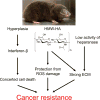Mechanisms of cancer resistance in long-lived mammals
- PMID: 29622806
- PMCID: PMC6015544
- DOI: 10.1038/s41568-018-0004-9
Mechanisms of cancer resistance in long-lived mammals
Abstract
Cancer researchers have traditionally used the mouse and the rat as staple model organisms. These animals are very short-lived, reproduce rapidly and are highly prone to cancer. They have been very useful for modelling some human cancer types and testing experimental treatments; however, these cancer-prone species offer little for understanding the mechanisms of cancer resistance. Recent technological advances have expanded bestiary research to non-standard model organisms that possess unique traits of very high value to humans, such as cancer resistance and longevity. In recent years, several discoveries have been made in non-standard mammalian species, providing new insights on the natural mechanisms of cancer resistance. These include mechanisms of cancer resistance in the naked mole rat, blind mole rat and elephant. In each of these species, evolution took a different path, leading to novel mechanisms. Many other long-lived mammalian species display cancer resistance, including whales, grey squirrels, microbats, cows and horses. Understanding the molecular mechanisms of cancer resistance in all these species is important and timely, as, ultimately, these mechanisms could be harnessed for the development of human cancer therapies.
Conflict of interest statement
The authors declare no competing interests.
Figures





Comment in
-
Insights on cancer resistance in vertebrates: reptiles as a parallel system to mammals.Nat Rev Cancer. 2018 Aug;18(8):525. doi: 10.1038/s41568-018-0033-4. Nat Rev Cancer. 2018. PMID: 29891962 No abstract available.
References
-
- Center for Disease Control and Prevention. United States Cancer Statistics: 1999-2014 Incidence and Mortality Web-based Report
Publication types
MeSH terms
Grants and funding
LinkOut - more resources
Full Text Sources
Other Literature Sources
Molecular Biology Databases

